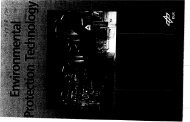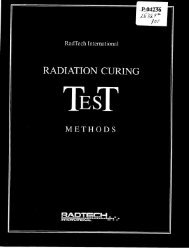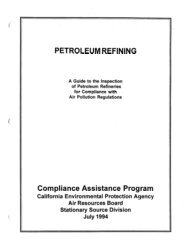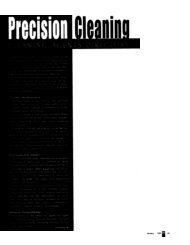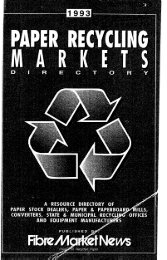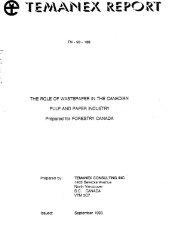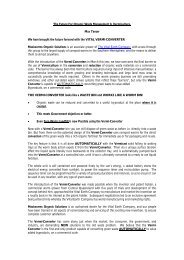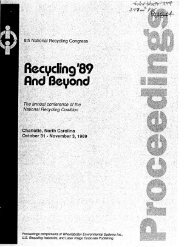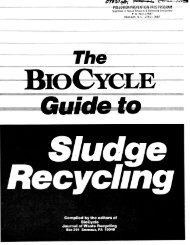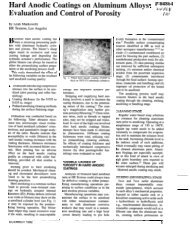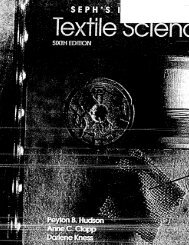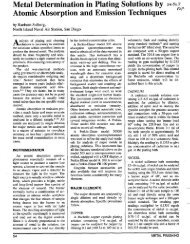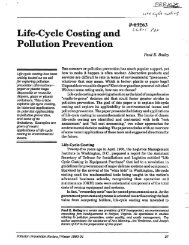Electronic Parts/Guidelines - infoHouse
Electronic Parts/Guidelines - infoHouse
Electronic Parts/Guidelines - infoHouse
You also want an ePaper? Increase the reach of your titles
YUMPU automatically turns print PDFs into web optimized ePapers that Google loves.
7<br />
GLASS CONTAINER<br />
general term applied to glass bottles and<br />
jars. Also includes beverage containers<br />
such as food, Ilquor, wine, beer, son drinks,<br />
medical, toiletries, and chemicals.<br />
GLASS, FLAT<br />
category Including sheet or window glass,<br />
plate glass, and laminated glass.<br />
GLASS<br />
an inorganic product of fusion that has<br />
cooled to a rigid condition without Crystallizing.<br />
Typically hard and brittle, and<br />
having a conchoidal fracture. It may be<br />
colorless or colored, and transparent to<br />
opaque. Masses or bodies of glass may be<br />
made colored, translucent or opaque by<br />
the presence of dissolved, amorphous, or<br />
crystalline materials. When a specific kind<br />
of glass Is Indicated, descriptive terms as<br />
flint glass, barium glass. and window glass<br />
should be used following the basic definition,<br />
but the qualifying term is to be used<br />
as understood by trade custom. Objects<br />
made of glass are loosely and popularly<br />
referred to as glass; such as glass for a<br />
tumbler, a barometer, a window, a magnifier,<br />
or a mirror. (1)<br />
GLASS, PRESSED AND BLQWN<br />
glass category including a broad classi-<br />
fication of kitchen and tableware, art<br />
objects, noveity items and the like, lighting<br />
and electronic glassware, and insulation<br />
glassware, insulation and manufactured<br />
products using glass fibre. (1)<br />
GRAVITY SEPARATION<br />
concentration or separation of a mix of<br />
materials based on differences in specific<br />
gravity and sizes of materials. (1)<br />
GRINDING<br />
particle-size reduction by attrition andlor<br />
high-speed impact. (1)<br />
GROUND WATER<br />
water beneath the earth’s surface that 611s<br />
.. -~ ~- - ---tl&~taund.~pockets (known 8s aquifers)<br />
and moves between soil particles and rock,<br />
supplying wells and springs. (7)<br />
GROUNDWATER FLOW<br />
flow of water in an aquifer or soil. That<br />
portion of the discharge of a stream which<br />
is derived from QrOUndWater. (1)<br />
GROUNDWATER RUNOFF<br />
that part of the groundwater which is dis-<br />
charged into a stream channel as spring or<br />
seepage water. (1)<br />
GROUNDWATER, FREE<br />
groundwater in aquifers not bounded or<br />
confined by impervious strata. (1)<br />
HAMMERMILL<br />
1. A broad category of high-speed rotating<br />
equipment that uses pivoted or fixed<br />
hammers or cutters on a horizontal or vertical<br />
shaft to crush, grind, chip or shred<br />
materials (1). 2. A type of crusher or<br />
shredder used to break up waste materials<br />
into smaller pieces. (7)<br />
HAUL DISTANCE<br />
the distance a collection vehicle travels<br />
from its last pickup stop to the solid waste<br />
transfer station, processing facility, or sanitary<br />
landfill. The distance a vehicle travels<br />
from a solid waste transfer station or processing<br />
facility to a point of final disposal.<br />
The distance that cover materials must be<br />
transported from an excavation or stockpile<br />
to the working face of a sanitary landfill. (I)<br />
HAZARDOUS WASTE<br />
1. Waste material that may pose a threat to<br />
human health or the environment, the disposal<br />
and handling of which is regulated by<br />
federal law (7). 2. Waste that requires<br />
special precaution in its storage, coilection,<br />
transportation, treatment or disposal<br />
to prevent damage to persons or<br />
property. there are no universally<br />
accepted definitions for the term hazardous<br />
waste, and each country defines the term<br />
with its own criteria. In a general sense,<br />
however, hazardous wastes include<br />
explosive, flammable, volatile, radioactive,<br />
toxic and pathological wastes.<br />
HEAW METALS<br />
hazardous elements inClUding cadmium,<br />
chromium, mercury, and lead which may<br />
be found in the waste stream as part of<br />
discarded items such as batteries, lighting<br />
fixtures, colorants and inks. (7)<br />
HEAW-MEDIA SEPARATION<br />
separation of solids into heavy and light<br />
fractions in a fluid medium whose density<br />
lies between the fractions. (1)<br />
Appendix E. Glossary Of Terms 89



